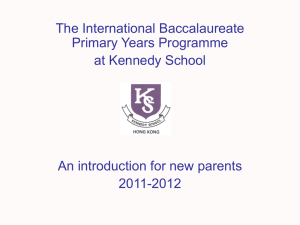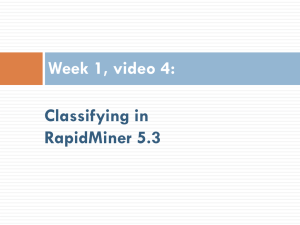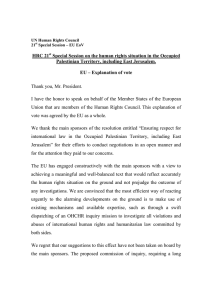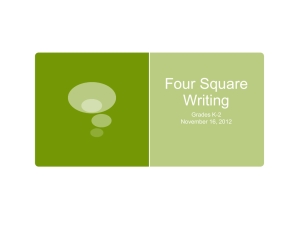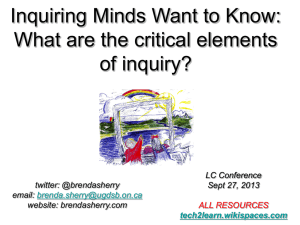PowerPoint Presentation - Avi Hofstein`s EDUC 512 PowerPoint
advertisement
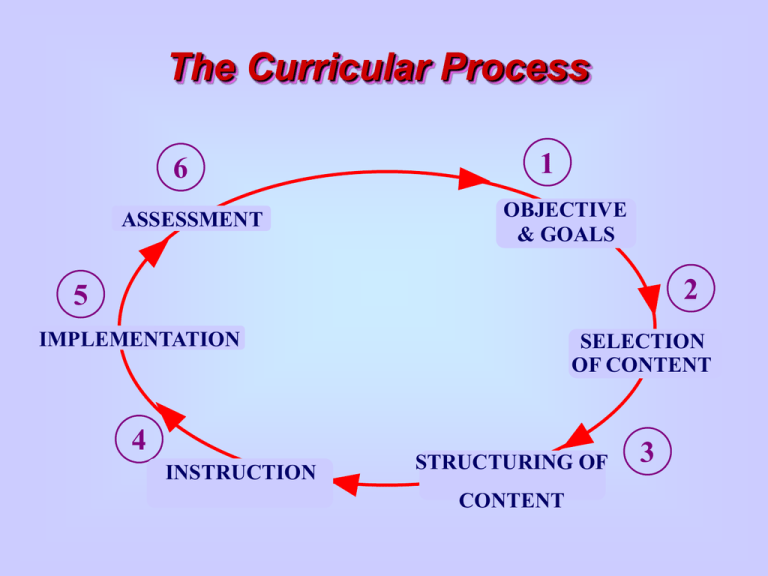
The Curricular Process 6 ASSESSMENT 1 OBJECTIVE & GOALS 2 5 IMPLEMENTATION 4 INSTRUCTION SELECTION OF CONTENT STRUCTURING OF CONTENT 3 Goals and Objectives Society Students Disciplines Goals & Cognitive objectives Affective Domains Psychomotor Bloom’s Taxonomy Cognitive Domain Knowledge-Recall knowledge of information Low Comprehension (understanding) Application applying scientific principles to other situations all the calculations in science Level Skills Analyzing break down material to its fundamentals. (identification of a compound in chemistry) Synthesis Formation of new understanding. Bringing together the parts into a new whole Evaluation making judgment based on evidence and external criteria High Level Skills Affective Domain Receiving Responding Curiosity Valuing In addition: Joy, attitude, interest Classroom learning environment Psychomotor * Manipulation * Imitation * Articulation - Sequencing * Precision Basic Goals of Science Education 1. Goals should be comprehensive enough to include the generally accepted objectives of teaching science 2. Goals should be understandable for other teachers, administrators and parents. 3. Goals should be neutral; that is, free of bias and not oriented toward any particular view of science teaching. 4. Goals should be few in number. 5. Goals should be differ in concepts and abilities from each other. 6. Goals should be easily applicable to instructional and learning objectives. Science Content in National Standards for the United States: Science as Inquiry Content Abilities Science Subject Matter Science and Technology Science in Personal and Social Perspectives History and Nature of Science Unifying Concepts and Processes Content of Science The High School Science 1960s’ and early 1970s’ Golden age of Science Curriculum History of Science Curricula Development and Implementation The 60s’ Main Goal: Preparing the next generation of: Scientists; Medical Doctors; and Engineers Goals for Teaching Science in the 60 s’ AAAS 1962 1. Science Education should present to the learner a real picture of Science to include theories and models. 2. Science Education should present an authentic picture of a scientist and his method of research. 3. Science Education should present the scientific method, research method and its limitations. 4. Present Science as a “Structure of Discipline”. As a result: The Structure of the Discipline PSSC - Physical Science Study Committee HPP - Harvard Project Physics BSCS - Biological Sciences Curriculum Study SMSG - School Mathematics Study Group CBA - Chemical Bond Approach CHEMS - Chemical Education Materials Study SCIS - Science Curriculum Improvement Study ESS - Elementary Science Study Nuffield Projects - in the UK Some Features In Physics (PSSC) ~ 1960s’ Fewer topics at greater depth, Greater emphasis on laboratory work, More emphasis on basic physics, Less attention to technological applications, Development approach showing origins of basic ideas of physics, and Increased difficulty and rigor of the course. Harvard Project Physics ~ 1970s’ The philosophy of this course is emphasized in eight points. 1. Physics is for everyone. 2. A coherent selection within physics is possible. 3. Doing physics goes beyond physics. 4. Individuals require a flexible course. 5. A multimedia system simulates better learning. 6. The time has come to teach science as one of the humanities. 7. A physics course should be rewarding to take 8. A physics course should be rewarding to teach. Chemistry Programs: CBA & CHEMSTUDY 1960s’ Schools: 10% 40% of schools CHEMStudy: Highly based on Experimental Work ASSUMPTIONS 1950-1960 If science is presented in a way it is known to scientists, it will be inherently interesting to all students. Any subject can be taught effectively in some intellectually honest form to any child at any stage of development. Common Elements of the “Golden-age” Curricula 1. There was less emphasis on social and personal applications of science and technology than in the traditional courses. 2. There was more emphasis on abstractions, theory, and basic science - the structure of scientific disciplines. 3. There was increased emphasis on discovery the modes of inquiry used by scientists. 4. There was frequent use of quantitative techniques. 5. There were newer concepts in subject matter. Common Elements of the “Golden-age” Curricula 6. There was an upgrading of teacher competency in both subject matter and pedagogical skills. 7. There were well integrated and designed teaching aids to supplement the courses. 8. There was primarily an orientation toward college-bound students. 9. There were similarities in emphasis and structure in the high school and junior high school programs. IAC: Interdisciplinary Approach to Chemistry Units (Modules) Reactions and Reason (Introductory), Diversity and Periodicity (Inorganic), Form and Function (Organic), Molecules in Living Systems (Biochemistry), The Heart of the Matter (Nuclear), Earth and its Neighbors (Geochemistry), The Delicate Balance (Environmental), and Communities of Molecules (Physical). Early 80s’: “A Nation at Risk” 300 different Reports were published raising a Concern about School Science: Content (Knowledge) Practice (experiences provided) Goals Equity (minorities and Gender issues) Yager and Harris in “Project Synthesis” Call for: Identifying new Goals for Teaching and Learning Science Science for: Personal needs Societal issues Career awareness The preparation of Future Scientists Historical Overview of Goals for Science Teaching; The 80s’ Teaching Science for: Scientific Knowledge Scientific Methods (Process) Societal Issues Personal Needs (Personal Development) Career Awareness The process of chemistry e.g. Inquiry The conceptual structure of chemistry The technological manifestations of chemistry Chemistry as a personally relevant subject The societal role and implications of chemistry O2(g) UV O(g) + O(g) O(g) + O2(g) O3(g) O3(g) + O(g) 2O2(g) The cultural aspects of chemistry It took more than 15 years for a new reform Major differences between the 60s’ & 90s’ The 90s’: Scientific Literacy for All One of the Key features STS ”Science and Technology are enterprises that shape, and are shaped by, Human thought and social actions” National Standards and Scientific Literacy New Standards in: Content (K-12) Pedagogy Assessment Professional Development Organization of Teaching and Learning Science Standards for Science Education Towards the 21st century Less emphasis on: Knowledge of concepts just for the presentation of; “Structure of a certain discipline”. Learning subject with out connections (separation of chemistry and biology chemistry and physics). Separation of Knowledge from process (inquiry). More emphasis on: Learning concepts in the context of: STS (Science -Technology - Society) Integration of key scientific concepts (e.g. Energy, Food, Natural Resources) Learning Science using inquiry (asking questions, hypothesizing) Science as personal and societal issues History and nature of science Global Science 1. The Grand Oasis in Space Students build an understanding of ecosystems. 2. Basic Energy/Resource Concepts Students develop an understanding of the laws governing energy and mineral resource use. 3. Mineral Resources Students learn how mineral deposits are formed, where they are located, and how they are mined. 4. Growth and Population Students learn about exponential growth and population issues. 5. Food, Agriculture and Population Interactions Students examine nutrition and the fundamentals of food production, modern agricultural practices, and the world food situation. 6. Energy Today Students build understandings of the energy sources for modern societies. Recommendations : 2061 The National Council’s recommendations address the basic dimensions of science literacy, which, in the most general terms are: Being familiar with the natural world and recognizing both its diversity and its unity Understanding key concepts and principles of science Being aware of some of the important ways in which science, mathematics and technology depend upon one another Knowing that science, mathematics, and technology are human enterprises and knowing what that implies about their strengths and limitations. Having a capacity for scientific ways of thinking Using scientific knowledge and ways of thinking for individual and social purposes Content Scientific Inquiry Abilities Discovery vs. Inquiry Discovery is included in the inquiry Discovery •Observing •measuring •Predicting •Inferring •classifying Inquiry •Formulating a problem •Hypothesizing •Design an experiment •Synthesizing knowledge •Demonstrating attitudes (curiosity) Welch: “A general process by which human beings seek information or understanding. Broadly conceived, inquiry is a way of thought”. Inquiry teaching is a way of developing the mental process of curiosity and investigation Content Unifying Concepts and Processes Science as Inquiry Physical Science Life Science Earth and Space Science Science and Technology Science in Personal and Social Perspectives History and Nature of Science Disciplines and tools of forensic science FORENSIC SCIENCE Decision making on: • Health • Population • Resources • Environment Changes of ideas • Evidence • Scientific arguments • Criticism • Endeavor STSP Science Personal Personal Technology Society Questions Science: What do I want to discover? Technology: What will I do with it? Society: How would we use it? Personal: How would it affect me? Science for all Americans: Benchmarks for Scientific Literacy – Project 2061 - More emphasis on the content - Covers an array of topics - “The more is less” The treatment of topics (cell, structure of matter, communication) differs from traditional approach by: Softening boundaries Connections are emphasized through the use of important conceptual themes: - Systems - Evolution - Energy (in chemistry, biology, physics, technology) More specifically it includes: - Benchmarks The nature of science The nature of mathematics The nature of technology The physical science The living environment The human organism Human Society The designed world The mathematical world Historical perspectives Habits of mind Recommendations : 2061 The National Council’s recommendations address the basic dimensions of science literacy, which, in the most general terms are: Being familiar with the natural world and recognizing both its diversity and its unity Understanding key concepts and principles of science Being aware of some of the important ways in which science, mathematics and technology depend upon one another Knowing that science, mathematics, and technology are human enterprises and knowing what that implies about their strengths and limitations. Having a capacity for scientific ways of thinking Using scientific knowledge and ways of thinking for individual and social purposes Integrated vs Disciplinary Science Why integrate? - DNA what is it? A concept in Biology? Chemistry? Forensic science? - Energy, is it a different concept in Chemistry, Biology, Physics? - Are we refering to nature of Biology, Physics, Chemistry or Nature of Science? - How can we teach Photosynthesis without Physics and Chemistry? - Making science more relevant for our students – working with meaningful problems and issues in the real world or in the lab setting. The U.S National Science Education Standards emphasize: Problem solving reasoning Making connections with other disciplines and prior learning The need for effective communication of ideas and results. The need for integration of various areas. The integrated approach vs Disciplinary Approach Questions asked Which one is more interesting for students? (close to their personal life?) Which one is more difficult for the teacher? (difficult to implement and organize in a coherent manner) Which one presents a more valid picture of science? (nature of science) Which one provides us with more opportunities to vary the classroom learning environment? What are the difficulties in teaching science by the integrated approach? First Option Applications _______________________________________ disciplines in science (concepts) _______________________________________ Second option Concepts __________________________________________ Application – issues __________________________________________ Disciplines and tools of forensic science FORENSIC SCIENCE Questions Science: What do I want to discover? Technology: What will I do with it? Society: How would we use it? Personal: How would it affect me? Reasons (Sources) for Misconceptions – Learning Difficulties Microscopic nature of phenomenon. (as opposed to macroscopic). Prior-knowledge (indigenous) Overload of information on memory Developmental stage concrete vs formal Models and simulations (abstraction, nature of modelsit’s limitations) Misconceptions transferred from books or teachers Laboratory (practical work) Typical Misconceptions - Structure of matter (particulate nature) - Optics - Galaxy - Structure of molecules - Bonding - Cell and its structure Matter can be represented in three levels (Johnston,1991) Macroscopic (physical phenomena) Microscopic (particles) Symbolic (scientific language) macro micro A model for learning symbolic Learning Models 1. 1960s’ and 1970s’, Piaget. Learning occurs when the individual: - Interacts with the environment - Passes through different stages of development – each characterized by the ability to perform a cognitive task (concrete Vs formal) In middle school many students are operating at the concrete level 2 Constructivism: Students construct knowledge by interpreting new experiences in the context of their prior knowledge. Teachers and students might have different interpretations regarding words and concepts Instructional techniques in Science education In teaching science: Students obtain opportunities to interact physically with learning materials Teachers provide materials for instruction (concreteness) Teachers vary instructional techniques with the goal in mind to increase effectiveness of teaching Instructional strategy refers to the way in which a science teacher uses: Materials Media Settings Behaviors To Create a learning environment that fosters desirable outcomes Instructional techniques I I Student centered Teacher centered Laboratory work (activities) Teacher’s demonstration PBL Small group activities Whole class discussions (lectures) Inquiry learning Computer simulations Field - trips Questions – answers - sessions Teacher’s role in different instructional techniques Teacher’s Roles Lecturing Providing Information Demonstrating Conventional teaching + + (+) Demonstration + Instructional Strategy Classroom discussion Managing Guiding And Facilitating + + (+) Laboratory class Helping to Analyze Data and Results (+) + + + + + + Group learning + + + Inquiry + + + + + + + + + Field trip + Computer simulation Individual learning + + APTITUDE 1. Ability 2. Development 3. Motivation b INSTRUCTION a 4. Amount 5. Quality c ENVIRONMENT 6. Home 7. Classroom 8. Peers 9. Television x y LEARNING Affective Behavioral z Cognitive Literature contains suggestions about how, in the context of school science education student’s motivation to learn can be enhanced: Suggestions relating to the nature, structuring and presentation of subject matter Suggestions concerning the nature of pedagogical procedures and techniques and of the classroom learning environment Achiever Curious Conscientious Social Motivation The need to achieve: Type of Motivation “the achiever” The need to satisfy one’s curiosity: The need to discharge duty: “the curious” “the conscientious” The need to affiliate with other people “the social” This is a call for varying Instruction Most of the teaching of science is conducted in heterogeneous classes We must cater for a variety of students of different needs and different motivations This calls for use of a variety of instructional procedures and techniques Relating Instructional Features to Students’ Motivational Characteristics Type of Activity Examples Comment on Suitability/Unsuitability Discovery/inquiry – oriented learning methods and Problem-solving Advocated in many science programs developed in the USA and UK during the 1960s and by NSES Suitable mainly for students with ‘curiosity’-type motivational pattern Open-ended learning activities (student-centered) Learning activities without clearly specifiable objectives Strongly preferred by the ‘curious’, but not other motivational groups which prefer clear teacher direction regarding educational goals Formal teaching with emphasis on information and skill transfer Conventional ‘traditional’ instructional procedures, involving frontal teaching (e.g. with clearly defined goals and objectives Preferred by ‘achievers’ and conscientious’ students because only low level of risk-taking is needed Collaborative learning activities Games, simulations, PBL Suitable for learners with a strong social motivation pattern. However, ’achievers’ are likely to be opposed to an involvement in this type of learning activity Questioning Techniques in Science Education Questioning , like hitting a baseball, is both an art and a craft. Questioning could transfer classroom from Traditional lecture setting Into Live student – centered community Teachers’ Questioning behavior Technique Taxonomies of questioning. Penick, et. al., suggested a practical approach. HRASE History Explanation Relationships Speculation Applications Compare ideas, activities, findings Based on students’ experiences (e.g. experience in the lab) Apply knowledge to new situation Finding evidence, critical thinking, control over variables Nature of phenomena: “how” does it work? Theoretical Approach Using Bloom’s and Krathwohl’s Taxonomies To Classify Questions Classification Sample Question Knowledge 1. How many legs has an insect Synthesis 2. What hypotheses would you make about this problem? Application 3. Knowing what you do about heat, how would you get a tightly fitted lid off a jar? Analysis 4. What things do birds and lizards have in common? Comprehension 5. Operationally define a magnet Evaluation 6. If you were going to repeat the experiment, how could you do it better? Receiving 7. Do you watch science shows on television? Responding 8. Do you talk to your friends about science? Valuing 9. What is your interest in earth science now compared to when you began the course? Valuing 10. What do you value about this film? Organizing 11. Can you argue using scientific facts, evidence, and data? Characterizing 12. Do you use problem solving techniques for solving problems at school or at work? Convergent vs Divergent Questions Allowing for a limited number of responses “yes” or “no” Usually the Ratio is: Allowing for a number of responses (e.g. in inquiry) 2:1 Allows wrong answers Provide enough time to answer WAIT - TIME Low Level vs High Level Techniques Low – Level Student Inquiry Teacher Student Student Student Student Higher Level Student Inquiry Teacher Student Student Student Allows collaboration Student Student Comparison of Traditional Classroom with Students’ – Central Classroom Comparison of a traditional Lecture Classroom with a Student-Centered Classroom Where We Were Where We Should Be • Telling the facts • Listening and questioning • Stating the theories • Conceptual understanding • Laboratories as selffulfilling exercises • Laboratories as openended investigations • Teacher as sage on stage • Teacher as facilitator • Fact validation • Inferences • Classical lectures • Inquiry and investigation • Group indoctrination • Individual instruction • Boot camp-like, threatening atmosphere • Positive setting; risk-free atmosphere Critical reading of an article Primary work of a scientist Secondary newspaper poster media Guidelines The materials should be appropriate to students’ abilities and interests. Use materials aligned with your goals for teaching. Assign a variety of reading sources: - Text books - Magazines - Articles (historical and societal significance) - Newspapers (scientific articles) Research Findings: Reading Scientific articles - Enhance critical thinking - Enhance ability to solve a problem - Develop creativity - Develop metacognition control awareness - Students who were involved in inquiry-type laboratories developed the ability to ask more and better questions resulting from reading a scientific article. Assessment of Student Learning - Measuring the quality of the experiences provided for the students - Assessment should have purpose in mind - Focused on data and content which is most important to the student - Assessment task should be authentic - Assessment should be fair - All the students experiences should be assessed - Students should understand (and be involved in) the assessment - Students should be aware of the criteria for assessment (weighting) - Assessment should be part of the development of P.C.K. (Pedagogical Content Knowledge) Evaluation involves the total assessment of Students’ learning to include: - Understanding of NOS - Subject matter (knowledge & understanding) - Multiple talent - Attitudes & interests - Skills and abilities (e.g. laboratory) - Motivation Assessment as a tool for improving instruction – e.g. Action Research Purpose of assessment: Learning difficulties Diagnostic Placing students Advise Prior knowledge How well the material is taught Formative Improve Methods of Instruction Modification of techniques Were the goals attained? Summative Grading (final) Decision making Decision making on: Programs (laboratory, etc.) Instructional technique A book to be selected Assessment methods used: Paper and pencil test (objective testing) Oral tests Essay-type tests Practical tests Experiment Following Instructions 10% Handle dexterity 35% Pre-inquiry stage Conclusions Inquiry Inquiry stage Questioning Hypothesizing 20% Planning Presenting results 10% Conclusions Social Skills Criticism and Summary 10% Communication skills Cooperation in groups Interest and curiosity Assessment of practical skills Continuous Assessment of Students Inquiry Laboratory in Chemistry Observations and “Hot reports” Observing Conducting Experiment 15% 1 2 3 4 5 6 Different Tests Type Validity Reliability Oral Very low Very low Essay High if defined clearly Low Usability no -Easy to administer -Difficult to assess -Difficult to prepare Completion test High Very high -Easy to answer -Easy to grade A good test: Multiple choice (American) High Very high -Difficult to prepare -Easy to answer -Good for diagnostics - Guessing factor Other assessment techniques: not tests Alternative assessment techniques: - Concept mapping: Organize ideas to find relations between concepts - Reading a journal (Method discussed in previous lesson) -Portfolio: Port – to carry or move Folio – paper The portfolio includes all the student’s documents, tests, concept- maps, and lab assignments. It is: Very comprehensive Highly individualized Includes all the student’s achievements Continuous Dynamic (regarding teacher-student interactions) Helps the student to identify weaknesses Increases the student’s responsibility and awareness Students can be involved in building the content and criteria Can include personal reflection Problems with the portfolio: A lot of work for the teacher The bigger the class the more the work Characteristics of a good assessment method differentiate valid reliable motivating objective fair usable Learning Environment as an Assessment Tool Central Question in the Affective Domain Do students like what they do? Are their feelings affecting their learning? How do we develop curiosity? Receiving Responding valuing Curriculum Learning Environment Aptitude Students Learning Learning Environment is constructed from the following three interceptions Teacher - student Student - student Student – learning materials Research on Classroom Learning Environment What does research say about classroom learning environment? It influences: Achievement Attitude and interest Students’ behavior. Measures of classroom learning environment Provide “eyes behind the classroom” Are sensitive to: Different instructional techniques: Inquiry VS non-inquiry approach Student-centered VS teacher-centered classroom Big and small classes LEI Assesses the classroom learning environment using Student’s Perception Scales Cohesiveness Diversity Formality Speed Goal-direction Satisfaction Organization Competitiveness Instruments LEI Science classroom SLEI Science laboratory SOLEI Outdoors Learning environment in science The Use of L.E. Measures by the Science Teacher My Class Inventory – includes: Satisfaction Friction Competitiveness Difficulty Cohesiveness Features of my Class Instrument Easy to administer and respond (yes/no) Actual VS preferred L.E The Δ measures students’ satisfaction with current L.E Stages in Action-Research Identification of problem 1 Planning 2 Second evaluation 6 Collecting evidence I 3 Collecting evidence II Making changes 5 4 Learning environment Student ability Teacher Achievement Learning environment Student ability Teacher Achievement


